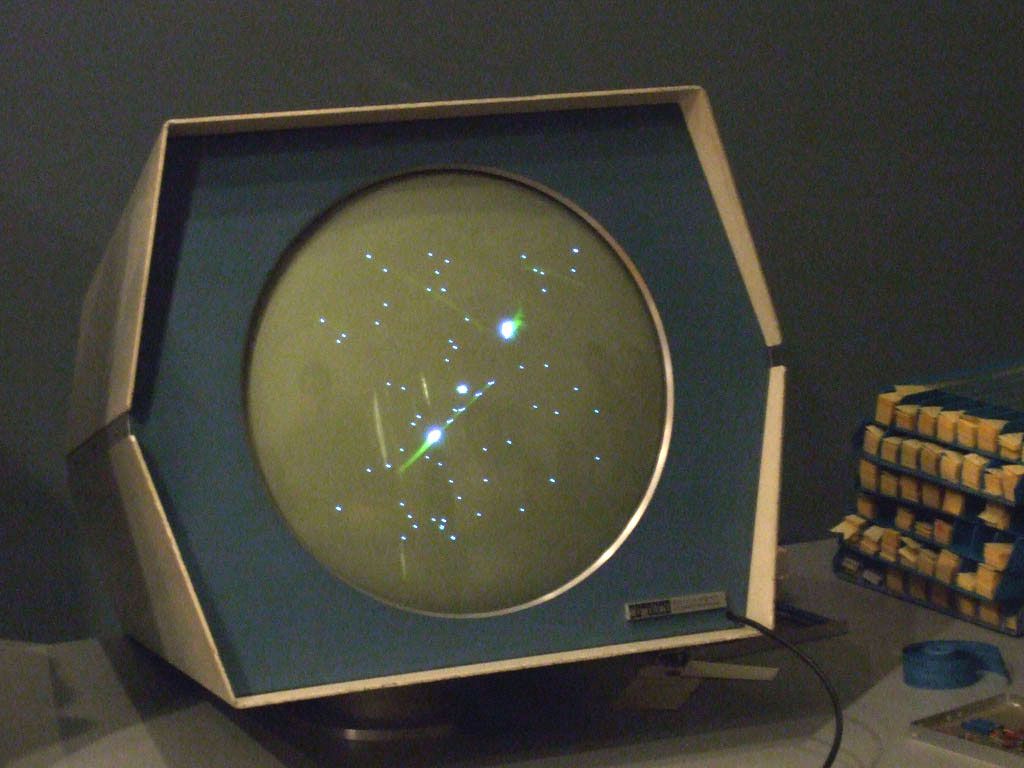5.1 Spacewar! vs. Computer Space vs. Galaxy Game
05 Early Arcades and Electricity
Spacewar! vs. Computer Space vs. Galaxy Game
Spacewar!
"The $120,000 PDP-1 may have been the size of a large car, but with its keyboard and screen it was in many ways the forerunner of the modern desktop computer...[Once the PDP-1 was up and running], after some debate the students hit on the idea of making a game. 'Wayne said: "Look, you need action and you need some kind of skill level. It should be a game where you have to control things moving around on the screen like, oh, spaceships." (Replay, p. 10)

Spacewar on the Computer History Museum's PDP-1
The first modern digital game was a game entitled Spacewar! Developed by computer scientists at MIT in late 1961, the game is playable here.
The game was developed on an expensive mainframe computer, and would remain imprisoned on these expensive computer systems for the coming years. It was only with the advent of home consoles that an affordable digital video game began to enter the home.
Computer Space vs. Galaxy Game
Spacewar! was undeniably popular among the college campuses and mainframe gamers. Here, we will trace how two early figures in the business of digital games, Bill Pitts and Nolan Bushnell, both saw the immense possibilities of creating a mass market version of it. They both intuited that it would require having a more affordable computer, but in their different approaches to solving that problem they created innovations that would shape the digital games industry.
Bill Pitts and Galaxy Game
“Spacewar! was one of the cool things at the A.I. lab,” [Pitts] recalled. “I had a friend from high school, Hugh Tuck, and when he was in town I’d take him to the A.I. lab and we’d play Spacewar!.” And it was during one of these Spacewar! sessions in 1966 that Tuck remarked that if only they could make a coin-operated version of the game they would get rich. With computers still hugely expensive and large, the idea was little more than a daydream. But then, in 1969, the Digital Equipment Corporation unveiled the $20,000 PDP-11. At that price, Pitts thought, a coin-op version of Spacewar! might be possible: “I called Hugh up and said we could now build one of these things.” While $20,000 was still prohibitive for arcades that were used to buying slot machines for around $1,000, the pair figured they could make one and work out how cheap they would need to make the machine for it to be commercially viable. With money from Tuck’s wealthy parents, the pair started adapting a PDP-11 to create their coin-operated version of Spacewar!, which they named Galaxy Game. They decided to charge players 10 cents a game or a quarter for three games. The winner of each game would get a free game. The idea was to ensure the machine was in constant use and therefore always taking money.
Donovan, Tristan. Replay: The History of Video Games (pp. 16-17). Yellow Ant. Kindle Edition.
When Bill Pitts was an electrical engineering student at Stanford in 1966, his interest in learning about computers lead him to spending long nights using the PDP-6 housed at Stanford's Artificial Intelligence research group. When he first saw Spacewar!, he was convinced that if he could create a coin operated version he would get rich. The original Spacewar! was created on the PDP-1, and all of the programming was done in software. Bill Pitts' attempts to recreate the game followed this logic – thus, he attempted to buy the PDP-11, a slightly less expensive version of the PDP-1, and use that to run multiple copies of the game at once. Due to the prohibitive expense of the $150,000 PDP-6, this plan didn't seem like it made sense – but, when the $20,000 PDP-11 came out, they believed they could play multiple versions of the game served from a single computer. That's why the Galaxy Game cabinets look the way they do below – a single PDP-11 is running both cabinets.

Bill Pitts | They Create Worlds
Nolan Bushnell and Computer Space
Then [Bill Pitts and Hugh Tuck] got a call from a man named Nolan Bushnell, who worked for a company called Nutting Associates. “He had heard of us through mutual contacts,” said Pitts. “He called me up and said ‘Hey, come on over and see what I’m doing. I know you’re building a version of Spacewar! using a whole PDP-11 and that’s gotta cost a lot of money and I just want to show you the one I’m doing because I think you’re going to lose a lot of money.”
Donovan, Tristan. Replay: The History of Video Games (p. 17). Yellow Ant. Kindle Edition.

An advertisement for Nolan Bushnell's Computer Space, featuring a view of the cabinet and text describing the game's features.
Nolan Bushnell's approach to creating an arcade-friendly version of Spacewar! revolved around his use of hardware, as opposed to software. By moving the game from the Data General Nova computer over to hardware, he was able to create a functional version of the game at a lower cost. Dedicated circuits would handle each of the game's functions, and the game would not rely on multiple screens, all of which appealed to arcades. The only caveat was that the game was redeveloped to support one player only, as opposed to two, meaning that it was now its own game entirely. Nolan Bushnell came up with this ingenious idea to place his entire game on an integrated circuit – running it on hardware rather than software, and saving money because it did not have to run off a computer. This insight would lead him to found Atari.
WATCHLIST
Galaxy Game (1971 Computer Recreation Inc) on MAME